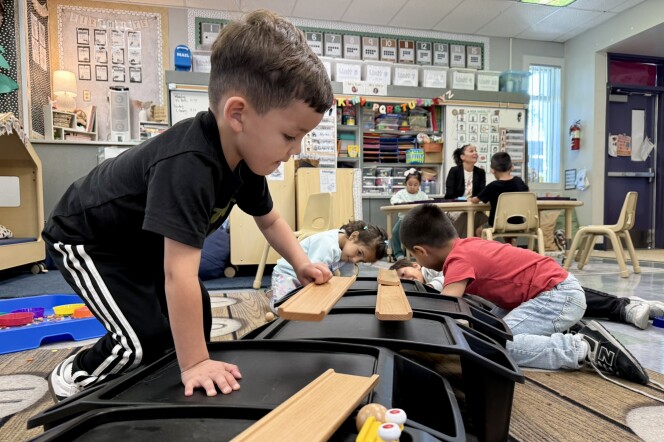With our free press under threat and federal funding for public media gone, your support matters more than ever. Help keep the LAist newsroom strong, become a monthly member or increase your support today.
For Teens Learning About Wage Theft In LA's Garment Industry, The Personal Is Political

For the six teenagers making time for a wage theft workshop this week, the issue isn't theoretical. It's personal.
Salma Rojas, a youth organizer for the Garment Worker Center, says these students grow up going to the factories and see the long hours their parents work in poor conditions and think that's normal.
At a workshop Tuesday, the students learned that the garment industry experiences the highest rates of wage theft in Los Angeles.
"It's known as the sweatshop capital of the U.S.," Rojas told the students. "That's a terrible title to have. But fortunately, there are resources to fight against wage theft."
Learning the law
The teens learned about overtime, wage theft and how to collect evidence to establish a wage theft claim.
"Knowledge is power," Rojas said. "The more they learn, the more they're able to empower themselves, their family members and community members to make changes that will improve the living conditions and working conditions for folks within these industries."
Jessica Chavez, 16, said her father's been a garment worker for more than 10 years. He's talked to Chavez about the piece-rate wages eliminated by SB 62, a 2021 law that gave garment workers hourly wages.

“He can work adequately with a pay that's adequate for him," Chavez said of the hourly wages. "It's more sustainable versus the inconsistent pay he used to have."
Why wage theft remains an issue
Victor Narro, a professor of Labor Studies at the UCLA Labor Center, says garment workers experience some of the worst rates of wage theft in the U.S.
He points to the 200-year-plus systemic practice of the industry's piece-rate system.
"We have the law in our books now [SB 62]," Narro said. "Now we have to work with the Labor Commissioner's office, Department of Labor Standards Enforcement and other agencies to try and eradicate the egregious wage theft step in the dominant industry."
A U.S. Labor Department study in March found that out of 50 contractors and manufacturers surveyed in Southern California, 80% violated the Fair Labor Standards Act. Half of those paid workers off the books and one contractor paid as little as $1.58 an hour.
What can be done
At the workshop the teens spun a wage theft wheel, with questions “how much do garment workers make an hour?” and “Is it wage theft if my employer combines my break & lunch?”
Students told Rojas that garment workers usually go to work at 7 a.m. and leave at 7 p.m.
And Rojas pointed out, “they're definitely not getting overtime."
That same Labor Department survey about conditions for garment workers found the vast majority of stolen wages reported in the industry are tied to Southern California. That might not be surprising given the outsize role L.A. now has in clothing still made in the U.S. As my colleague David Wagner recently reported:
If you buy clothing made in the U.S. there’s a good chance it comes from a factory just like this. L.A. accounts for an estimated 83% of all sales of clothing cut and sewn in America, and downtown’s Fashion District is the epicenter of that activity.
Narro says teaching youth about wage theft is a good way to expand their ability to help their parents and family members deal with it.
“Wage theft is a family crisis, he said. “It impacts workers, it impacts their families. It’s very common to find immigrant families where you find multiple wage theft violations because members in the family work in different industries.”

Many of his students are first-generation students with parents working in the garment industry and other low-wage industries.
"When the students in my class learn about labor laws and when they learn about labor enforcement, they use that knowledge to then help their family members," he said.
Takeaways from the workshop
Before the youth wage theft workshop ended, Rojas had the kids play hot potato while music played. When the music stopped and a student was left holding the ball, they had to recite something they learned in class.
Some responded with how long it takes to resolve a wage theft, the statute of limitations and what a meal break violation is.
Jessica Chavez, who was one of the most outspoken students all day, said she learned about the different forms of wage theft, double pay and how to file a wage theft claim — good things to know as she prepares to enter the workforce.
"This program helped me with a bunch of stuff," she said. "This can also give me the tools to better myself, not only in the industry but in my life."







